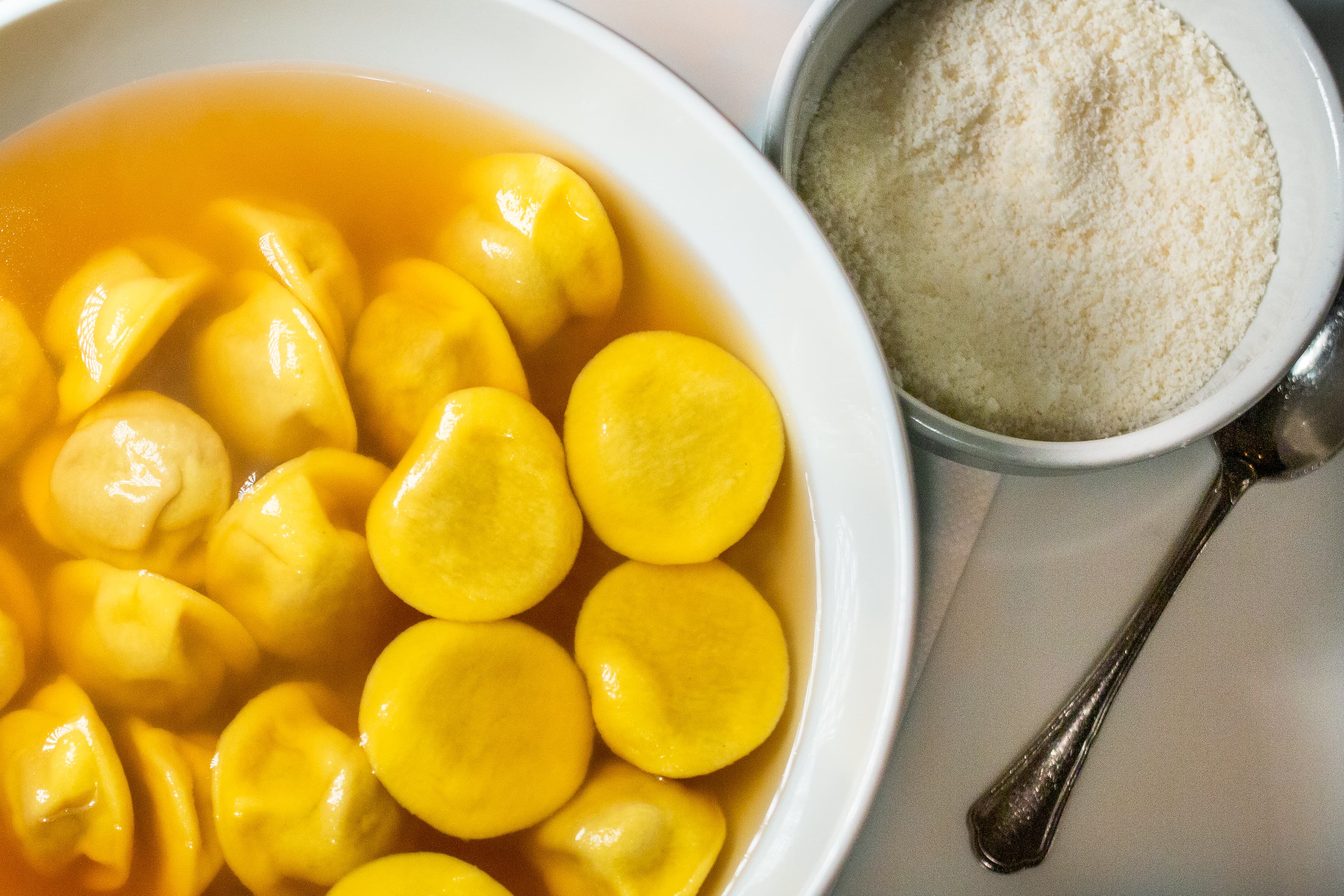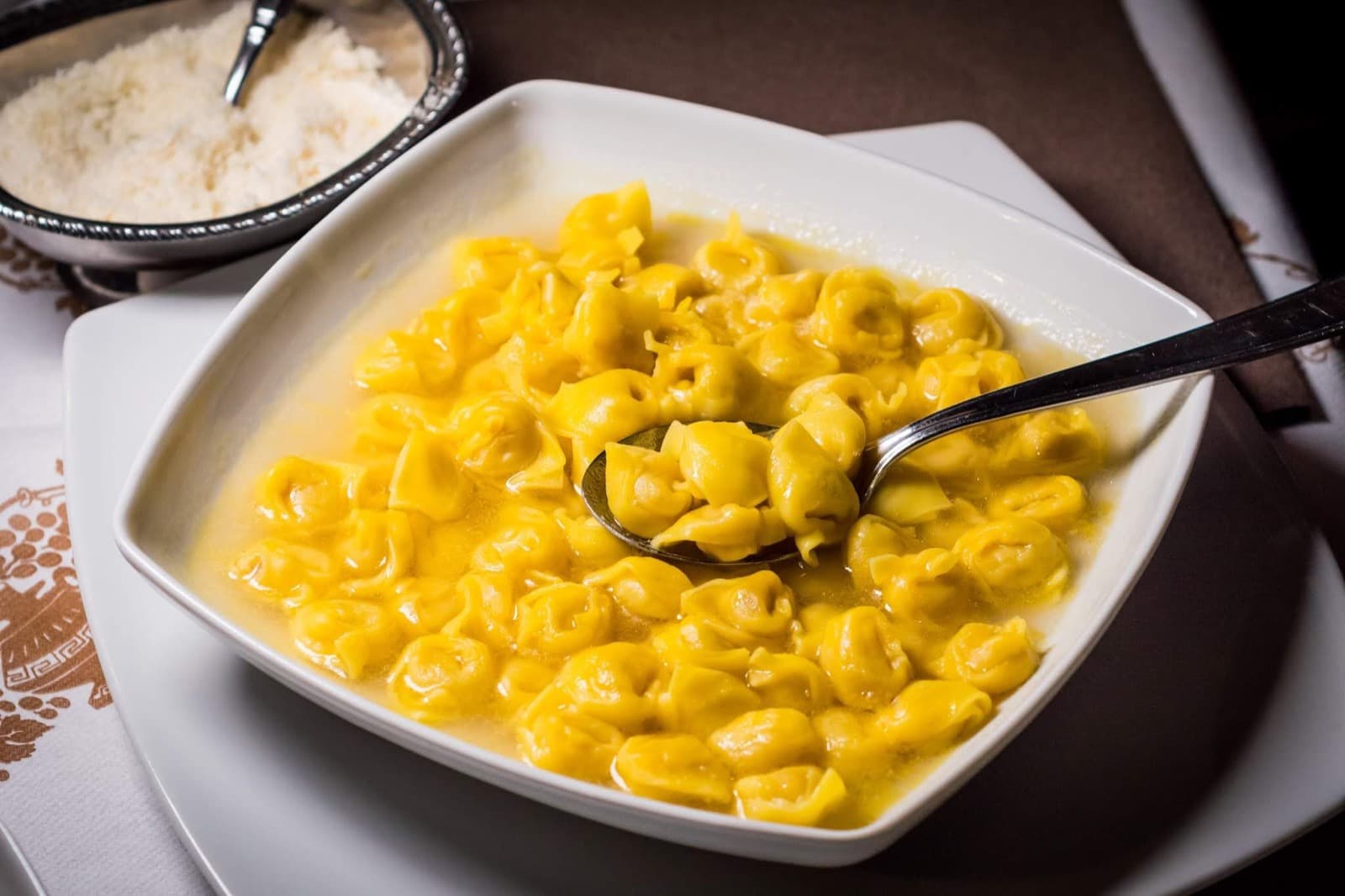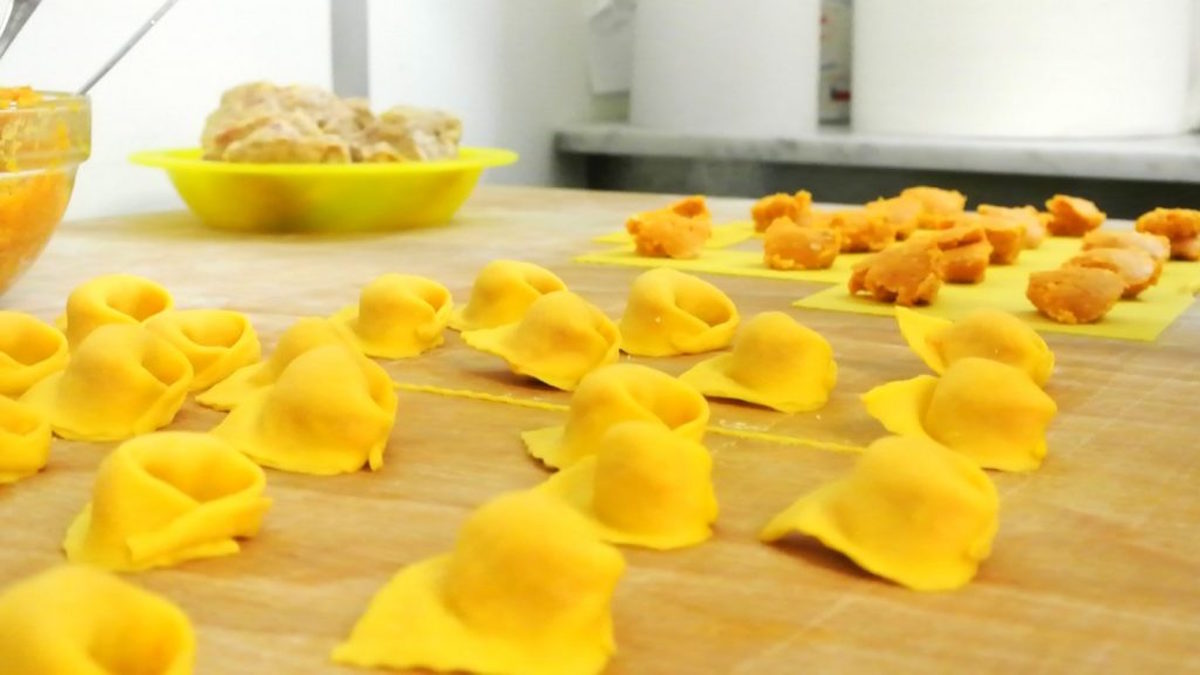Rich in history and flavor, the cuisine of Emilia-Romagna is a galaxy of diverse culinary traditions. Each of its nine provinces preserves numerous recipes distinguished by raw materials of the highest quality, daughters of a peasant knowledge with ancient origins.
Tortellini, tortelli verdi and tortelli con la coda, anolini, cappelletti and cappellacci, garganelli, tagliatelle, lasagna, passatelli: whether dry or in broth, stuffed or not, hand-prepared egg pastas are the region's calling card.
A few simple ingredients such as eggs and flour are enough to create a long list of tasty and delicious first courses, which differ in shape and type of filling.
Everything is then made tastier by the seasonings and sauces. The most famous is undoubtedly ragù, whose recipe varies from city to city. Also never missing is the traditional chicken or capon broth, which flavors the dishes and warms the hearts of anyone who tastes it.
If Romagna is the home of cappelletto stuffed with raviggiolo cheese, in Bologna and Modena the king of the table is tortellino, strictly made with meat. In the Ferrara area, on the other hand, cappellacci di zucca (pumpkin filled pasta) triumph, while in the Parma and Piacenza area we find tortelli with herbs and ricotta cheese.
Finally, not to be missed are tagliatelle, a true pillar of Emilia-Romagna cuisine when it comes to egg pasta.
The signature dish of Piacenza cuisine, pisarei e fasò is a dish of ancient peasant tradition. These are gnocchetti made by hand with stale bread and flour, seasoned with a sauce made from beans, lard pesto, onion and tomato.
According to some, the name Pisarei comes from the mispronunciation of the Piacenza word"b issa" (biscia, meaning snake), and refers to the particular shape of the pasta before it is cut into gnocchetti. According to others, however, the term could be related to pisar, or pestare/schiacciare (squish) in Spanish.
Anolini are a type of stuffed egg pasta typical of the Emilia area, whose origins can be traced back to the 12th century.
At the center of a dispute over paternity between Parma and Piacenza, anolini is the dish of major celebrations, such as Christmas. They are small round ravioli with a serrated edge that enclose a mixture of beef stew, Parmesan cheese, seared bread and spices. They are usually served swimming in a tasty chicken or capon broth.
In the Piacenza variant, anolini (in dialect "anvëin") are slightly smaller than their Parma cousins, are shaped like a half-moon, and have a filling made with beef stew (but some people also use pork). In the Parma area, however, they are circular in shape, and are jokingly nicknamed "lifesavers" for this reason. The filling is made with beef stew accompanied by Parmigiano-Reggiano.

Tortelli are one of the typical dishes of Emilia-Romagna, particularly the areas around Parma, Piacenza and Reggio Emilia. Tradition has as many as four different versions (with herbs, potatoes, pumpkin and chestnuts), which differ according to the type of filling.
Their origin seems to date back to the medieval period, particularly the need to eliminate meat on the lean days of the particular Catholic holidays.
However, those with herbs (also simply called green tortelli) remain the best known and most representative of the area: a simple egg pasta stuffed with ricotta and spinach or Swiss chard, served with melted butter, Parmigiano Reggiano and a few spices (pepper or nutmeg).
Other variants include tortelli con la coda typical of the town of Vigolzone, in the province of Piacenza.
Imperial soup is a fairly common dish in the Bologna and Ravenna area, where it usually triumphs on tables during important occasions.
Made with a mixture of semolina, eggs, grated Parmesan cheese, butter and nutmeg, it is baked and then cut into squares and served in capon broth.
Tortellini are a true delicacy of Emilian cuisine. Cooked in beef and chicken or capon broth, they are small egg pasta caskets that embrace a sumptuous filling of meat, prosciutto crudo, mortadella and Parmigiano-Reggiano.
For centuries the cities of Bologna and Modena disputed the paternity of this dish, at least until the late 1800s, when it was decided that the official birthplace of tortellino was Castelfranco Emilia, midway between the two contenders. And it is precisely here that the traditional Tortellino Festival still takes place in the second week of September.
Each family in Emilia holds its own recipe for this specialty; however, there is also an "official" recipe, filed with the Bologna Chamber of Commerce by the Dotta Confraternita del Tortellino.

Cooked and enjoyed all over the world, but best known as the signature dish of Italy abroad, lasagna verde alla bolognese is a true institution.
The origins of this dish are lost in the mists of time, but it was in Bologna that the recipe took shape and substance.
At the base is a sheet of fresh green egg pasta cut into rectangles, which are then overlaid directly in a baking dish and alternated with layers of meat sauce, béchamel sauce and Parmigiano Reggiano before being placed in the oven.
As with any traditional dish, there are several variations on lasagna. However, it was the Italian Academy of Cuisine that, after careful analysis, filed with the Bologna Chamber of Commerce what is now believed to be the original recipe for this all-Emilian delicacy.
Tagliatelle is one of Emilia-Romagna's monumental dishes, an icon tout court of Italian cuisine.
There are countless recipes revolving around this thin type of egg pasta, which differ depending on the type of sauce. Among them, the most famous is certainly the one with ragù alla Bolognese, a great classic loved especially during Sunday lunches with family or friends.
Since 1972 the traditional Emilian recipe has been filed with the Bologna Chamber of Commerce, which sanctions the size of the pasta and the ingredients of the sauce; in reality, every family has its own version. However, they all agree on two things: the minced meat in ragù alla Bolognese must contain a mixture of pork and beef, and it must be cooked slowly.
A pastry made from 00 wheat flour and eggs that wraps around a filling of yellow pumpkin pulp, Parmigiano-Reggiano, breadcrumbs, salt, pepper and a pinch of nutmeg. These are the ingredients behind the recipe for Cappellacci di Zucca IGP, the signature dish of Ferrara cuisine.
A recipe with noble origins, born in the mid-1500s from the mind of the court cook of Alfonso II d'Este, which has come down to us. The peculiarity of the name (in dialect caplaz) recalls the typical straw hats once worn by peasants.

Also known as sfoglia lorda or stuffed pasta, spoja lorda is an easy and tasty first course typical of Romagna, particularly the province of Ravenna.
Prepared for holidays and large family meals, they are presented as small squares of egg pasta with jagged edges, filled with ricotta and raviggiolo cheese (a typical cheese of the Tuscan-Romagna Apennines), eggs, Parmesan cheese and a pinch of salt.
Depending on taste and availability, spoja is usually served in meat broth (capon or chicken), but it is not uncommon to find it also paired with sauces such as white beef ragout.
In capon broth or served with a meat sauce, cappelletti (called caplèt in dialect) is one of the traditional stuffed pastas of Romagna, prepared especially at Christmas time.
Similar to a tortellini but larger in size, this egg pasta is cut into squares, filled with a mix of cheeses (ricotta, raviggiolo or casatella, Parmigiano-Reggiano), and closed so as to obtain the characteristic hat shape.
It is not easy to disentangle the many variations that exist, which differ both in the way the cappelletti are closed and in the way they are filled. If in the Rimini area the presence of meat (perhaps even more than one type) is almost a must, the Ravenna and Cesena traditions prefer a lean filling made with herbs and cheese.
Eggs, breadcrumbs and Parmigiano-Reggiano cheese, with an addition of a lemon zest and nutmeg: these are the basic ingredients of the recipe for passatelli, one of the tastiest dishes in the gastronomic tradition of Emilia-Romagna, mentioned by the famous Pellegrino Artusi in his work "Science in the Kitchen and the Art of Eating Well."
Resembling cylinders or large short spaghetti, passatelli are a quick dish to prepare. A tool called a "ferro" (iron) or, alternatively, a potato masher with large holes is usually used.
They are cooked in meat or vegetable broth, and are fairly short to prevent them from losing their texture.
Once enjoyed on festive occasions, basotti (bazòtt in dialect) are a typical dish of the Tuscan-Romagna Apennine area, particularly the Alto Savio valley and the Bagno di Romagna area.
These fresh pasta noodles are cooked in a pork bone broth and then placed inside a pan, placed on the embers along with several layers of lard, pecorino cheese and breadcrumbs.
Once the broth is completely absorbed by the pasta, you get very crispy and flavorful squares of tagliolini.
Among other Emilia-Romagna pasta dishes to try we recommend:
Piacenza and its province:
In Reggio Emilia and its province:
In Modena and its province:
In Bologna and its province: